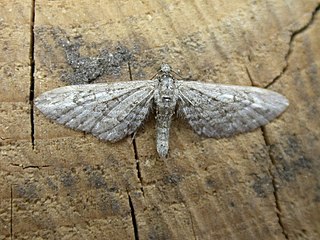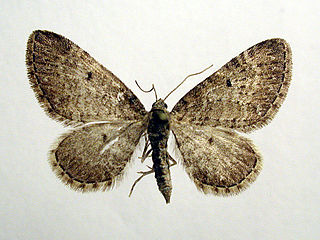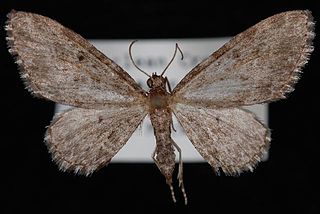
The tawny speckled pug is a moth of the family Geometridae.

The juniper pug or juniper looper is a moth of the family Geometridae. The species was first described by Michael Denis and Ignaz Schiffermüller in 1775. It is found throughout the Palearctic and in the Nearctic.

Eupithecia indigata, the ochreous pug, is a moth of the family Geometridae. The species can be found in Europe. and across the Palearctic as far as the Altai mountains It primarily colonizes pine forests, mixed pine forests and pine plantations. In the Alps it rises to heights of 1800 metres.

Eupithecia nanata, the narrow-winged pug, is a moth of the family Geometridae. The species was first described by Jacob Hübner in 1813. It can be found all over Europe including Russia and Ukraine. In the Alps it occurs up to 2,200 metres (7,200 ft) above sea level and in the Pyrenees to 2400 meters. The species prefers dry or boggy heathlands.

Eupithecia satyrata, the satyr pug, is a species of moth of the family Geometridae. It was described by Jacob Hübner in 1813. It is found from Ireland, through northern and central Europe east to all of Russia and central Asia and western Siberia to Tibet. It is also present in North Africa and North America.

Eupithecia nimbicolor is a moth in the family Geometridae first described by George Duryea Hulst in 1896. It is found in North America from eastern Newfoundland and Labrador to western British Columbia and from Alaska to Arizona.

Eupithecia lachrymosa is a moth in the family Geometridae first described by George Duryea Hulst in 1900. It is found in North America from central Saskatchewan west to southern Vancouver Island, north to British Columbia and Alberta and south to California.

Eupithecia niveifascia is a moth in the family Geometridae first described by George Duryea Hulst in 1898. It is found in North America from south-western Alberta west to Vancouver Island, north to northern coastal British Columbia and south to New Mexico.
Eupithecia amasina is a moth in the family Geometridae first described by Otto Bohatsch in 1893. It is found in Russia Turkey, Lebanon and Syria.
Eupithecia amplexata is a moth in the family Geometridae. It is found in China, Russia and Japan.

Eupithecia subbrunneata is a moth in the family Geometridae. It is found in China and Russia.
Eupithecia duena is a moth in the family Geometridae. It is found in Ecuador and Peru.
Eupithecia interrubrescens is a moth in the family Geometridae. It is found in Tibet.
Eupithecia irambata is a moth in the family Geometridae. It is found in India (Sikkim).
Eupithecia junctifascia is a moth in the family Geometridae. It is found in Colombia and Costa Rica.
Eupithecia lacteolata is a moth in the family Geometridae. It is found in Russia and Turkey.
Eupithecia mejala is a moth in the family Geometridae. It is found in Ecuador, Bolivia and Peru.
Eupithecia subalba is a moth in the family Geometridae. It is found in Mexico.
Eupithecia subfumosa is a moth in the family Geometridae. It is found in Japan.
Eupithecia submiranda is a moth in the family Geometridae. It is found in Suriname.








